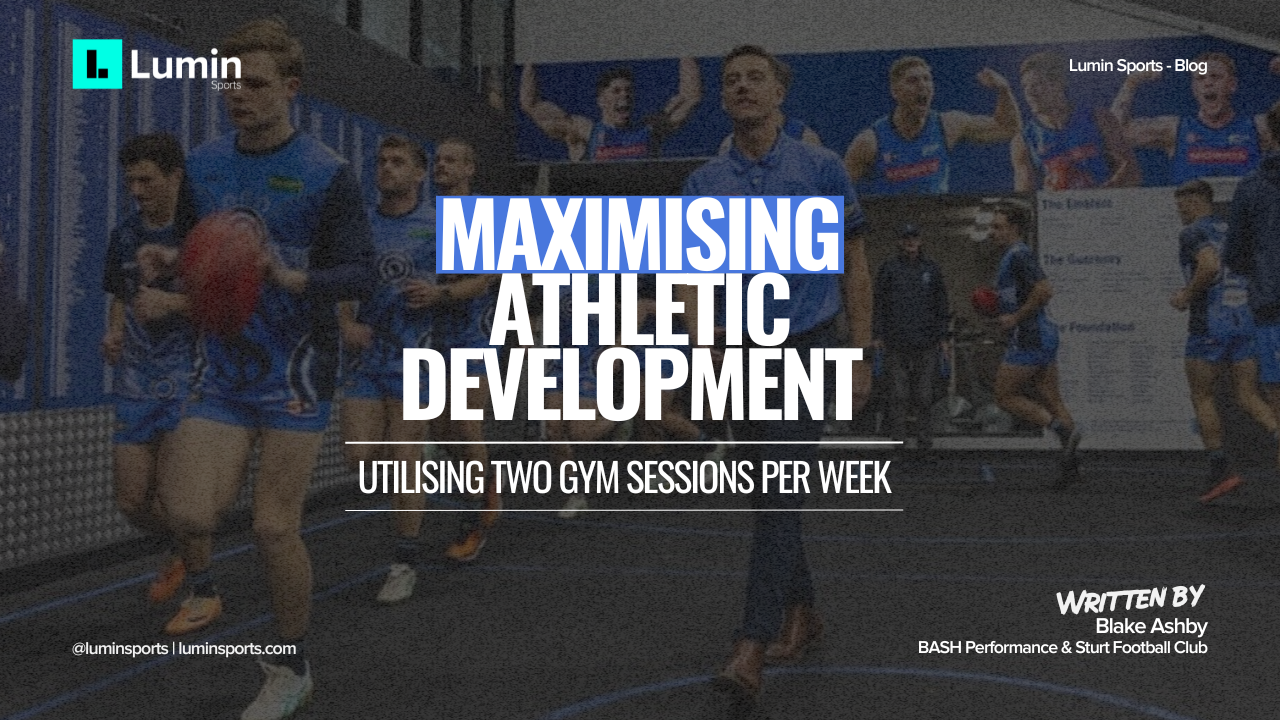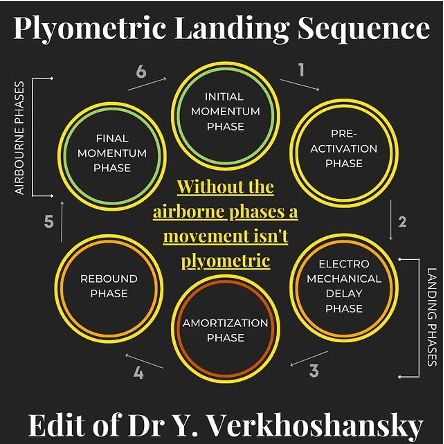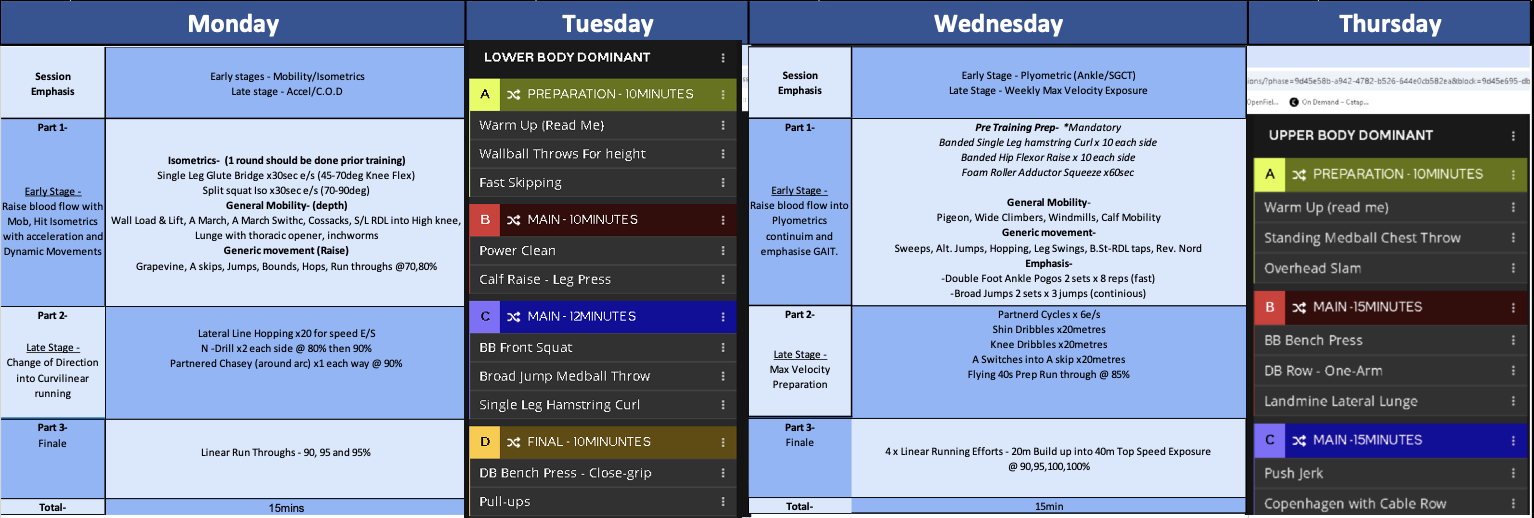Developing athletes with limited contact time

Written By Blake Ashby
High Performance Manager, Sturt Football Club
To access as a downloadable PDF, click the link below:
https://lumin.to/BlakeAshbyBlogDownload
For many football players in the South Australian National Football League (SANFL), strength and conditioning programs are often constrained by time due to training schedules, work, study, and other commitments. However, with careful planning, just two gym sessions per week can effectively target all major joints, planes of motion, movement patterns, and athletic traits while maintaining a primary focus on strength development. The key to success lies in periodisation, if you have taken care of your “big rocks” in athletic development but still need to integrate key capacity and/or application modalities then seeking a systematic approach to every on-field or gym session to integrate efficient movement strategies such as plyometrics and isometrics into either warm-up is key. Microdosing these methods throughout the year during the warmup can enhance athletic development by improving tissue capacity, stretch-shortening cycle function, and neuromuscular efficiency (Behm et al., 2021; Kubo et al., 2017).
Before we go any further, for those unfamiliar with the SANFL, it’s regarded as the best football league outside of the professional Australian Football League (AFL.) In most cases, SANFL players hold regular jobs outside of their football obligations.
Plyometric training, even in low doses, enhances explosive power and movement efficiency by improving rate of force development (RFD) and tendon stiffness, which are critical for acceleration, jumping, and change-of-direction performance (Markovic & Mikulic, 2010). There is an approach that allows us coaches to gain the adaptation needed with carefully progressively overloading the tissue to get a positive response over a long period of time in the warm-ups (on-field or gym). Similarly, isometric training has been shown to increase tendon stiffness and maximal force production while being joint-friendly, making it a valuable tool for enhancing strength without excessive fatigue (Kubo et al., 2017). By strategically embedding these modalities into warm-ups and gym sessions, athletes can maximise their adaptations without detracting from skill-based training or recovery.
Efficiency in exercise selection is crucial when working with limited training time. Each session should target all muscle groups and movement patterns at least 2-3 times per week, ensuring balanced development while avoiding redundancy. Warm-ups present an opportunity to microdose specific stimuli, allowing for progressive adaptations without disrupting the primary objective of preparing for training (McBride et al., 2008). For example, incorporating short-duration isometric holds or submaximal plyometrics in warm-ups can improve neuromuscular readiness while simultaneously developing strength qualities.
Every exercise, session, and implementation must have a clear ‘why.’ With only a limited number of exercises available per week, knowing the purpose behind each selection is critical for maximising return on investment. Prioritising high-impact exercises—those that deliver the greatest adaptations in strength, power, and movement efficiency—ensures athletes develop optimally while minimising unnecessary fatigue. By systematically integrating strength, plyometrics, and isometrics into training, athletes can sustain year-round progress and long-term development, setting themselves up for success beyond just the immediate season.
Key Topics Covered in this Blog
1. Strength as the Foundation of Athletic Performance
Strength underpins all athletic qualities and should be maintained year-round due to long term nature of developing elite strength qualities.
A systematic approach to exercise selection ensures consistent progress throughout the season.
Strength development should be a key focus while adapting to individual athlete needs.
Periodising training to focus on one primary adaptation (e.g., power, speed, strength) while maintaining strength.
Microdosing Plyometric and Isometric Work
Integrating plyometric and isometric exercises into strength programs year-round.
Using warm-ups (both gym and field-based) to include small doses of plyometric and isometric work if time is of the essence.
Ensuring consistent exposure to these qualities without overloading the athlete.
Planning and Integration
Structuring programs to target all key movements efficiently within two weekly sessions.
Using strategic programming to ensure long-term development beyond a single season.
Understanding that mastery of certain exercises (e.g., weightlifting variations) takes time.
Being adaptable with programming to accommodate athletes’ varying schedules, skills, and commitments.
Strength as the Foundation
Strength underpins all other athletic qualities, serving as the foundation for improvements in speed, power, endurance, and overall resilience. Greater muscular strength is strongly associated with enhanced force-time characteristics, which directly influence an athlete’s ability to generate force rapidly, improving sprinting, jumping, and change-of-direction performance (Suchomel, Nimphius & Stone, 2016). A well-structured program ensures that athletes consistently progress their strength across all facets of lifting and muscular contractions while emphasising specific phases such as maximal strength, speed-strength, strength-speed, power, and strength endurance within each phase or session. This systematic approach allows for the development of multiple physical qualities without compromising recovery or performance in skill-based training and competition.
Long-term strength training has been shown to enhance general and sport-specific skills while simultaneously reducing injury risk (Suchomel et al., 2016). Stronger athletes demonstrate superior performances across a range of tasks due to their ability to produce higher levels of force and accelerate their movements more effectively. The rate of force development (RFD), a key performance characteristic, is positively correlated with maximal strength levels, emphasising the necessity of year-round strength training to optimise athletic performance (Suchomel et al., 2016). Additionally, strength training enhances an athlete’s ability to potentiate earlier and to a greater extent, leading to improved power output in competitive settings.
There is no substitute for strength when it comes to building an athlete’s physical capacity. Implementing structured strength training programs year-round ensures that athletes develop the necessary physical attributes to meet the demands of their sport. Strength should not be viewed as a seasonal priority but rather as an ongoing process that underpins every aspect of athletic performance, expressing and absorbing forces to injury mitigation (Suchomel et al., 2016).
Microdosing Strength Throughout the Week
Understanding the ‘why’ and ‘how’ behind exercise selection and execution is crucial, especially when time is limited. Microdosing key strength and power qualities throughout the week is an effective way to maintain long-term adaptations, build tendon resilience, and ensure continued strength development even when gym sessions are restricted. When training time is scarce, strategically distributing strength work across warm-ups and field sessions can sustain key adaptations without compromising primary training goals.
For example, lower-body strength works such as distal hamstring development can be microdosed effectively within on-field warm-ups. If gym sessions are limited to two per week, there may not always be space to include dedicated hamstring exercises. However, systematic exposure through warm-ups can uphold strength and mitigate injury risk. A progressive plan over a season might begin with 20-second Bosch holds, progress to 30 seconds, then transition into dynamic variations before incorporating a four-week Nordic progression plan. These exercises, when implemented in warm-ups before submaximal field training, can reinforce long-term tendon and muscle adaptations without detracting from the session’s primary focus (Behm et al., 2021; Kubo et al., 2017).
Beyond hamstring work, microdosing can be applied to other key athletic qualities. For instance, pairing low-volume isometric groin, quad, or glute work with upper-body gym sessions can ensure consistent exposure without accumulating unnecessary fatigue. Similarly, isometric and plyometric exercises such as pogo jumps, ankle stiffness drills, or tendon-loading exercises can be embedded in warm-ups to support tendon health and maintain power outputs throughout the season (Markovic & Mikulic, 2010; McBride et al., 2008). The key to successful microdosing is balancing intensity and volume to align with overall weekly training loads. For example, distal hamstring work should not be programmed before high-intensity sprint sessions due to its role in knee flexion and potential impact on sprint mechanics (Van Hooren & Bosch, 2017).
By carefully planning and periodising microdosing strategies, athletes can receive a continuous stimulus for strength and tendon health without overloading or disrupting key training goals. Strength is not always about maximal loading it is about consistent exposure, strategic timing, and progressive overload over time. Whether targeting hamstring health, groin integrity, or power development, microdosing ensures that no critical quality is neglected, even in time-restricted schedules.
Microdosing Plyometrics for Long-Term Strength and Power Gains
Plyometric training is widely recognised for its ability to enhance neuromuscular function, speed strength, and tendon stiffness. However, traditional high-volume plyometric sessions are not always feasible within limited training schedules. Microdosing plyometrics strategically distributing small doses throughout the week has emerged as a practical approach to maintaining and developing athletic qualities without excessive fatigue accumulation (Ramírez-Campillo et al., 2018; Bohm et al., 2021).
Defining Plyometrics: Does Contact Time Matter?
Plyometric exercises are defined by the stretch-shortening cycle (SSC), where a rapid eccentric contraction is immediately followed by a concentric action, allowing energy storage and release via elastic structures like tendons (Markovic & Mikulic, 2010). Contact time plays a role, but it does not solely determine whether an exercise is plyometric. Instead:
1. Fast SSC movements (<250ms): Sprinting, bounding, and drop jumps maximise tendon elasticity and neuromuscular efficiency (Komi, 2000).
2. Slow SSC movements (>250ms): Countermovement jumps and loaded jump squats still engage the SSC but involve greater muscular force production (Van Hooren & Bosch, 2017).

